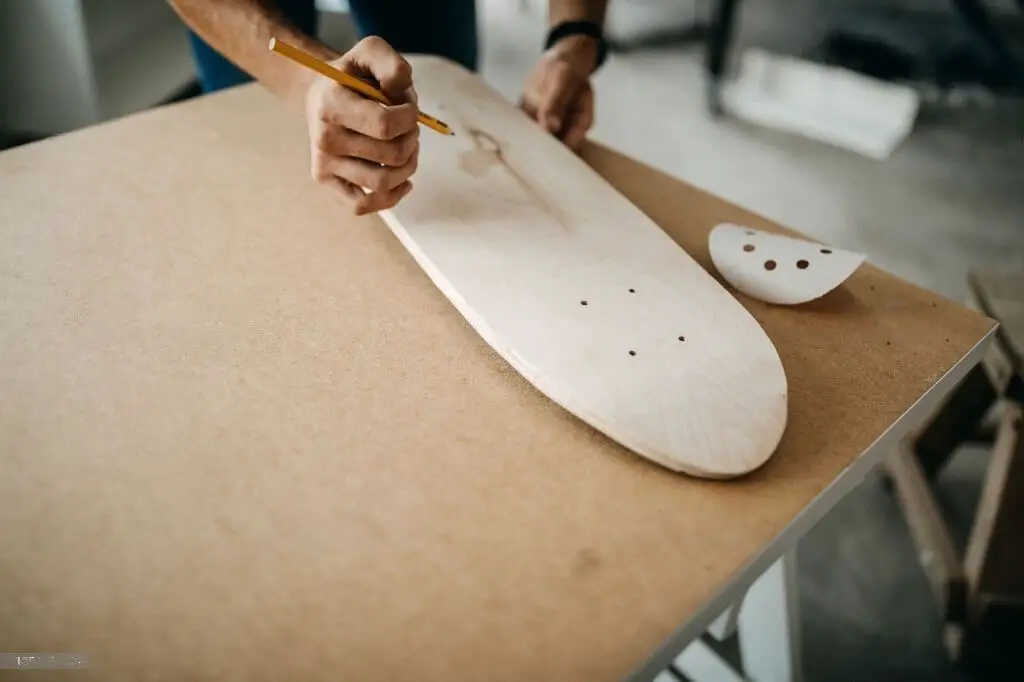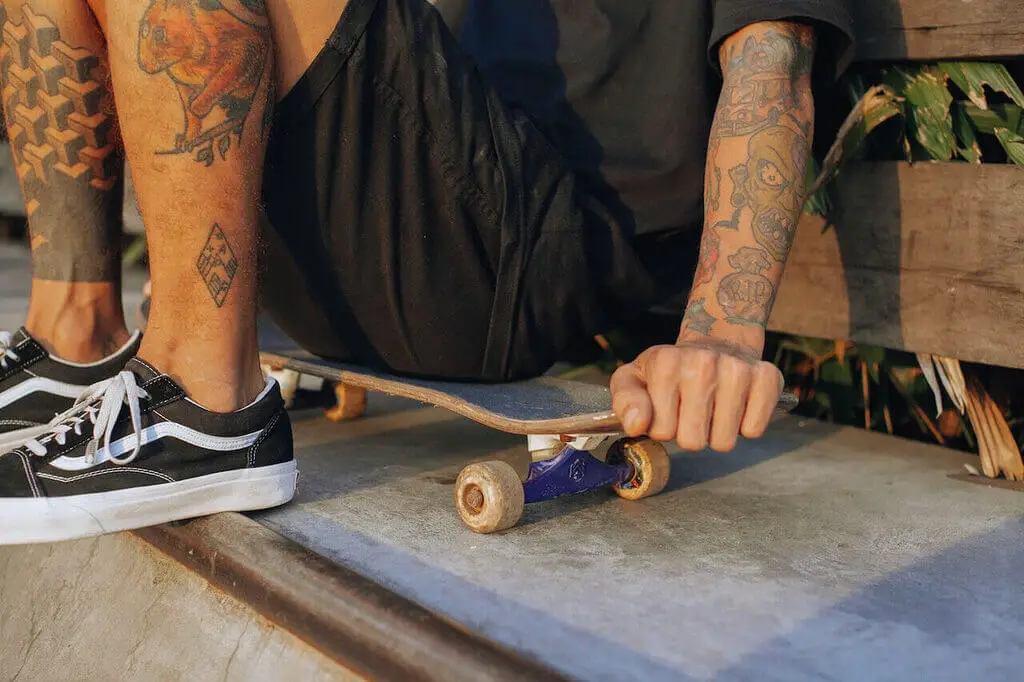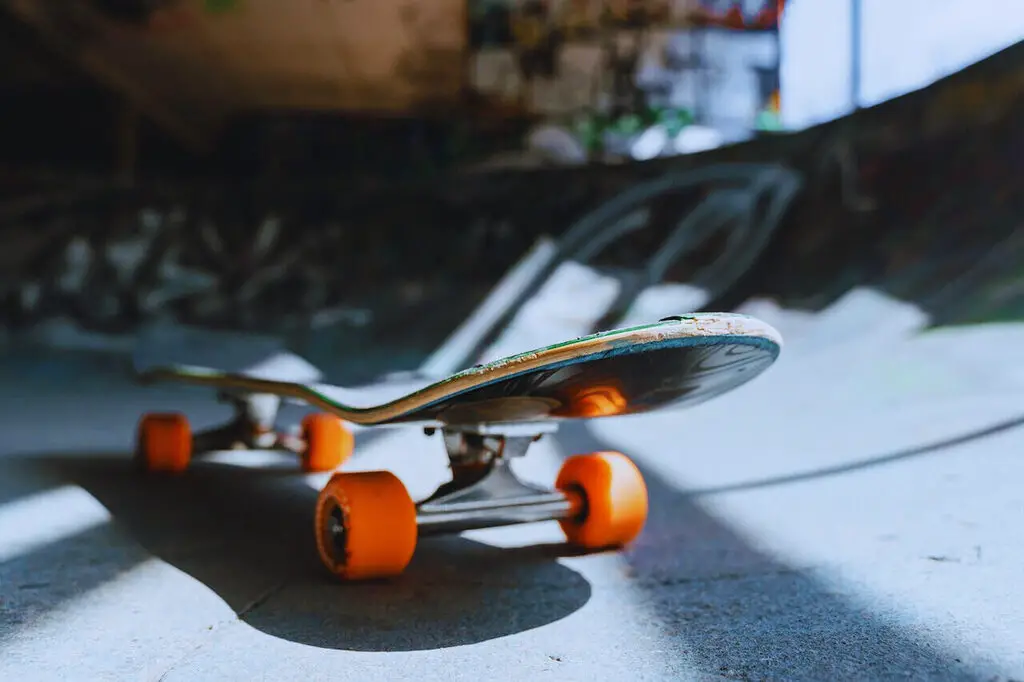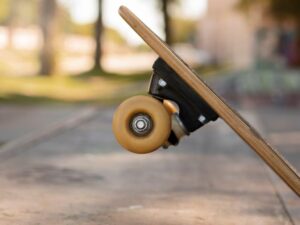Skateboard decks are uniquely designed with 7-ply maple wood. Generally, these woods are from North America or the Great Lakes, to be specific. The skateboard trucks support the skateboard deck and attach polyurethane wheels to the skateboard deck.
Skateboarding is an exciting sport, and it is gaining popularity these days. Many people like you are getting curious about skateboards. Today, we will answer a common question – what is a skateboard deck made of?
Here, we are going to discuss the topic in detail. We will also explore the ways to make your perfect skateboard deck. So, join us in the journey and quench your curiosity!
What Is A Skateboard Deck Made Of?
Skateboard decks are made of high-quality 7-ply maple wood. Sometimes there might be eight plies on the deck. But the concept is the same: to make a solid and resistant skateboard deck.
A 7-ply maple deck supports your body weight well. Most of the boards you see are made of American Maple Wood. Canadian Maple Woods are also getting popular these days.
However, you can get skateboard decks made of other materials too. Like, penny boards contain plastic instead of wood. Again, longboard decks come from bamboo.
Depending on your usage, there might be a change in the width of a deck. A more expansive deck is better for beginners and intermediate skateboarders who feel comfortable with a narrower deck for trick performance,
How Skateboard Decks are Made: A Step-by-Step Guide
Skateboard decks are typically made from seven layers of maple wood veneer, which are laminated together under high pressure. The grain of each layer is alternated to create a stronger and more durable deck. Once the deck is laminated, it is shaped and sanded, and then graphics and finishes are applied.

Step 1: Cutting the Veneers
The first step in skateboard deck production is to cut the maple wood veneers to size. This is done using a large, computerized saw. The veneers are typically cut to a thickness of about 1/8 inch.
Step 2: Laminating the Veneers
Once the veneers have been cut to size, they are laminated together under high pressure. This is done using a hydraulic press. The press applies a tremendous amount of pressure to the veneers, which causes the glue to bond them together.
Step 3: Shaping the Deck
Once the deck has been laminated, it is shaped using a template. The template ensures that the deck has the correct dimensions and shape. The deck is shaped using a variety of tools, including saws, routers, and sanders.
Step 4: Sanding the Deck
Once the deck has been shaped, it is sanded to a smooth finish. This is done using a variety of sanding machines.
Step 5: Applying Graphics and Finishes
Once the deck has been sanded, graphics and finishes are applied. Graphics can be applied using a variety of methods, including screen printing, digital printing, and heat transfer. Finishes can be applied using a variety of methods, including painting, staining, and clear coating.
Step 6: Quality Control
Once the graphics and finishes have been applied, the deck is inspected for quality control. This ensures that the deck meets the manufacturer’s standards for strength, durability, and appearance.
Why Maple Wood?
Maple wood is the preferred wood for skateboard decks because it is strong, durable, and flexible. Maple wood is also relatively lightweight, which is important for skateboarders who want to perform tricks and stunts.
Why Alternate the Grain?
Alternating the grain of each layer of veneer helps to create a stronger and more durable deck. This is because alternating the grain helps to distribute stress more evenly throughout the deck. This reduces the risk of the deck breaking or cracking under pressure.
Skateboard deck production is a complex process that requires precision and skill. However, the end result is a high-quality product that can withstand the rigors of skateboarding.
Materials Used in Skateboard Decks

The two main types of materials used in skateboard decks are wood and composites.
- Wood: Wood is the most common material used in skateboard decks, and it is typically made from maple. Maple is a strong and durable wood that is also flexible, which is important for skateboarding.
- Composites: Composites are a mixture of two or more materials, and they are often used in skateboard decks to improve performance and durability. Some common composites used in skateboard decks include bamboo, fiberglass, and carbon fiber.
Pros and Cons
Each material used in skateboard decks has its own unique advantages and disadvantages.
Wood
- Pros: Strong, durable, flexible, relatively inexpensive
- Cons: Can be heavy, susceptible to chipping and cracking
Bamboo
- Pros: Lightweight, durable, flexible, sustainable
- Cons: Can be more expensive than wood, not as strong as maple
Fiberglass
- Pros: Strong, lightweight, stiff
- Cons: Expensive, not as flexible as wood or bamboo
Carbon fiber
- Pros: Extremely strong and lightweight
- Cons: Very expensive, not as flexible as wood or bamboo
Table that summarizes the key pros and cons of each material:
| Material | Pros | Cons |
| Wood | Strong, durable, flexible, relatively inexpensive | Can be heavy, susceptible to chipping and cracking |
| Bamboo | Lightweight, durable, flexible, sustainable | Can be more expensive than wood, not as strong as maple |
| Fiberglass | Strong, lightweight, stiff | Expensive, not as flexible as wood or bamboo |
| Carbon fiber | Extremely strong and lightweight | Very expensive, not as flexible as wood or bamboo |
Ultimately, the best way to choose the right skateboard deck for you is to try out different decks and see what feels best. You can also ask other skaters for their recommendations.
Different Types of Skateboard Decks
What is a Skateboard Deck Made of? Skateboard decks come in a variety of shapes and sizes, each designed for a specific type of skateboarding. Here is a brief overview of some of the most common types of skateboard decks:

- Street decks: Street decks are typically smaller and more maneuverable than other types of decks. They are designed for performing tricks on street obstacles, such as stairs, handrails, and benches. Street decks typically have a width of 7.5 to 8.5 inches and a length of 31 to 32 inches.
- Vert decks: Vert decks are larger and more stable than street decks. They are designed for skating in skateparks and bowls. Vert decks typically have a width of 8.5 to 9.25 inches and a length of 32 to 33 inches.
- Longboards: Longboards are much longer and wider than street decks or vert decks. They are designed for cruising and carving on sidewalks, bike paths, and hills. Longboards typically have a width of 9.25 to 10.25 inches and a length of 36 to 48 inches.
- Cruiser decks: Cruiser decks are a type of shortboard that is designed for cruising and commuting. They are typically shorter and wider than street decks, with a width of 8.0 to 8.5 inches and a length of 28 to 30 inches.
In addition to these general categories, there are also a number of specialized skateboard decks designed for specific disciplines, such as downhill skateboarding, pool skating, and freestyle skateboarding.
How Materials Affect Skateboard Deck Performance

Skateboard deck materials have a big impact on the board’s performance, including its durability, weight, flex, and pop.
Durability
The durability of a skateboard deck depends on the type of wood used and how well it is constructed. Hard maple is the most durable type of wood used in skateboard decks, but it is also the heaviest. Bamboo is another durable material that is often used in skateboard decks. It is lighter than maple, but it may not be as strong.
Weight
The weight of a skateboard deck is important for skaters who want to perform tricks. A lighter deck will be easier to flip, but it may not be as stable for landing big tricks.
Flex
The flex of a skateboard deck is the amount of bend that the deck has. A deck with a lot of flex will be easier to flip, but it may not be as stable for landing big tricks. A deck with less flex will be more stable, but it may be more difficult to flip.
Pop
Pop is the amount of rebound that a skateboard deck has. It is important for skaters who want to perform tricks such as ollies and kickflips. A deck with a lot of pop will be easier to launch into the air.
How to Choose the Right Skateboard Deck
When you’re first starting out in skateboarding, it can be tough to know where to begin. There are so many different types of boards and accessories to choose from, and it can be hard to know what’s right for you.
One of the most important decisions you’ll need to make is which skateboard deck to buy. The deck is the foundation of your board, and it will have a big impact on your skating style and performance.

Few things to keep in mind when choosing the right skateboard deck:
- Your height and weight: Skateboard decks come in a variety of sizes, so it’s important to choose one that’s appropriate for your height and weight. If you’re a taller or heavier person, you’ll need a wider deck.
- Your skating style: Different skating styles require different types of decks. For example, if you’re into street skating, you’ll want a narrower deck that’s easier to flip and maneuver. If you’re into park skating, you’ll want a wider deck that’s more stable and provides more support.
- The size and shape of the deck: Skateboard decks also come in a variety of shapes. Some decks have a more traditional popsicle shape, while others have a more asymmetrical shape. The shape of the deck can affect its performance in different ways. For example, a popsicle-shaped deck is better for flipping and sliding, while an asymmetrical deck is better for carving and pumping.
Once you’ve considered all of these factors, you can start shopping for a skateboard deck. Be sure to try out different decks before you buy one to make sure you find one that feels comfortable and rides well.
Where are Zero Skateboards Made?
When it comes to the manufacturing of Zero Skateboards, the brand has chosen to keep it close to home. Zero Skateboards are proudly made in the United States. The company operates its own manufacturing facility in California, where skilled craftsmen meticulously create each board. By keeping the production process in-house, Zero Skateboards ensure that every skateboard meets their strict quality standards. This level of control over the manufacturing process also allows them to innovate and experiment with new materials and techniques.
The Manufacturing Process of Zero Skateboards
Now that we know where Zero Skateboards are made, let’s take a closer look at the manufacturing process. It all starts with the selection of high-quality materials. Zero Skateboards use a combination of Canadian maple wood and a specialized glue that ensures durability and flexibility. The selected wood is then cut into shape, sanded, and pressed together to form the deck. The next step involves attaching the trucks, wheels, and bearings to complete the skateboard. Throughout the entire process, the craftsmen pay great attention to detail, ensuring that each skateboard is built to withstand the demands of skateboarding.
The Materials Used in Zero Skateboards
The materials used in the production of Zero Skateboards play a crucial role in their performance and durability. Canadian maple wood is known for its strength and resilience, making it the ideal choice for skateboard decks. This type of wood can withstand the impact and pressures of tricks, ensuring that the board remains intact even after countless hours of use. Additionally, Zero Skateboards use a specialized glue that creates a strong bond between the layers of wood, enhancing the overall strength and stability of the deck. These carefully selected materials contribute to the longevity and high performance of Zero Skateboards.
The Impact of Manufacturing Location on Quality and Sustainability
The location where a product is manufactured can have a significant impact on its quality and sustainability. In the case of Zero Skateboards, their decision to produce their boards in the United States speaks volumes about their commitment to these aspects. By manufacturing their skateboards domestically, Zero Skateboards can closely monitor the production process and ensure that each board meets their stringent quality standards. This level of control allows them to deliver consistently high-quality skateboards to their customers.
Moreover, producing skateboards locally reduces the carbon footprint associated with transportation. By eliminating long-distance shipping, Zero Skateboards minimize their impact on the environment. Additionally, manufacturing in the United States supports local industries and economies, further promoting sustainability and social responsibility.
Comparing Zero Skateboards to Other Brands
Now that we have explored where Zero Skateboards are made and the impact of manufacturing location, it’s worth comparing Zero Skateboards to other brands in the market. While many skateboard companies outsource their manufacturing to countries with cheaper labor costs, Zero Skateboards have chosen to invest in their own production facility. This decision allows them to maintain superior quality control and deliver skateboards that are built to last. By choosing Zero Skateboards, you can be confident that you are supporting a brand that prioritizes quality and sustainability.
Conclusion
Skateboard decks are a great way to show your personality. Moreover, handmade designs will make you look cool among your friends. The self-satisfaction is exemplary!
You will find different types of skateboards in the skate shops, and the number of options is never-ending. Manufacturers are finding new ways to make the perfect design for you. But a handmade skateboard deck beats them all.
This article showed the way to make a skateboard at your home. It also answers your question about what a skateboard deck is made of. Do not slack off; get your skateboard deck with the perfect material!
FAQ’s
What kind of wood are skateboard decks made of?
Skateboard decks are made of Maple tree wood. Maple trees provide the perfect type of wood that can sustain damage and last for a long time. They are common in Europe and North America.
What is the best material for a skateboard deck?
The best material for a skateboard deck is Maple wood. Manufacturers may use components like plastic or metal to build a skateboard deck. But maple wood provides the perfect conditions like flexibility and durability for a skateboard deck
What is a skateboard board made of?
Skateboard boards are usually made of 7-ply maple wood. But, you can also find plastic-made boards like Penny Board or metal-made boards.
How many layers of wood are in a skateboard?
There are seven wood layers in a skateboard. But you can find 8- or 9-layered skateboard decks too.
What are real skateboards made of?
Real skateboards are typically made of a combination of materials. The deck is commonly constructed from layers of maple wood, known for its strength and flexibility. The trucks, which connect the wheels to the deck, are usually made of aluminum. The wheels are composed of polyurethane, providing grip and durability for smooth rides.
What kind of plywood is used for skateboards?
Real skateboards are typically made of a combination of materials. The deck is commonly constructed from layers of maple wood, known for its strength and flexibility. The trucks, which connect the wheels to the deck, are usually made of aluminum. The wheels are composed of polyurethane, providing grip and durability for smooth rides.
What Are Skateboard Deck Rails Made Of?
Stiff and thin strips on the bottom edge of your skateboard deck are skateboard deck rails. You can also define a rail as the outer edge of a skateboard.Deck rails are made from molded plastics. High-rebound and soft-ish Urethane is the crucial compound for plasticThe cheap injection-molded plastic is a slick barrier for the deck, which keeps your deck’s graphics intact and safe.







